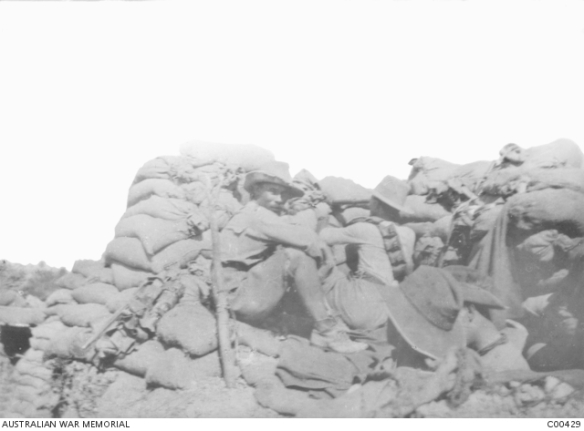Sniper Sing with his spotter
Tpr William Edward (Billy) Sing of the Light Horse who was on Gallipoli is said to have sniped more than 150 Turks. He was awarded the DCM. After Gallipoli he joined an infantry battalion (the 31st Bn AIF) and went to France, though I remember reading that his sniping skills were not utilised as much in France as they were in Gallipoli.
This ace Australian sniper cut down 150 Turks. To the Anzacs in the trenches he was “The Assassin”… On Wednesday, May 19, 1943, William Edward Sing died alone in his room at the house where he boarded in West End, Brisbane… with five shillings… a man whose name was once known to an army and a nation.
As the northern summer intensified in June 1915, the Australian Fifth Light Horse Regiment was allocated as its area of responsibility, the ground around what was soon to be called Chatham’s Post.
It was a Queensland unit and its officers and men were primarily from the country areas.
like most of his fellow members of the Regiment, had grown up and worked with horses in the Australian bush.
Part of their cumulative stock-in-trade was an ability to ride well, estimate distance carefully, track strayed stock and animal pests, and to fire both rifle and shotgun accurately.
Sing’s considerable skills with a rifle were well-known in his central Queensland home district, even before the outbreak of World War One.
He was a member of the Proserpine Rifle Club and a leading kangaroo shooter around his home town of Clermont (about 250 km south-west of Proserpine).
Sing signed his enlistment papers at Proserpine on October 24, 1914, two months after the outbreak of World War One. He became a member of the First AIF.
The following about sniping is from “Damn the Dardanelles”
“Private Walter Gifford, aged 18 of the Australian 10th Battalion survived several near misses, one of which he writes about ‘I was in the front line at Anzac having shot for shot with a sniper when our Lt Tarrant came along. “You can’t shoot straight” he said. He took my rifle and stood up and then fell straight back into my arms, dead,-shot through the head……………….”
“The Turkish snipers, though numerous and deadly and with the advantage of higher ground, by no means dominated the battlefield. Some Australians and New Zealanders, accustomed to rifles from boyhood, survived and prospered as snipers, some being credited with sixty or seventy victims. One of the best known snipers was ‘Hitchie’ of the 11th Battalion, from Western Australia-No.443 Postal Corporal H.V. Hitch. He was officially the 11th Battalion Postmaster, but he was also a dead shot. He lived in a little dugout behind Battalion HQ and from there he distributed mail, on the infrequent occasions that mail arrived. Mostly Hitchie was engaged in the agreeable pursuit of sniping. A remarkable figure on Gallipoli, he had a dark tanned face surrounded by a great growth of beard, dressed in shorts and carrying a captured Turkish bandolier and a German Mauser rifle. As the Battalion historian commented: ‘Hitchie looked more like one of the faithful than a son of the Golden West.’ He was asked again and again to ‘go a nd get’ certain Turkish snipers, and he seldom went in vain. He would sometimes be away for more than a day, and was several times arrested as a spy and had to be vouched for by somebody from his own battalion. He was always profoundly annoyed that a good Australian should be taken for a Turk”
Laffin should have checked his sources more thoroughly. No ‘Lieutenant Tarrant’ died at Gallipoli.
Tpr Sing’s name features in the snipers of WW1 ranking. He is, in fact, number 1 – but, officially, they only credit the man with 150.
Lieutenant Percy Grace, a Maori officer of the Wellington Battalion, NZEF, organised a team of crack snipers at Gallipoli to beat the Turkish snipers at their own game, which up till that time they’d been winning hands down. Within a week the tables had been completely turned by this band of men and Shrapnel Valley was safe to walk in, where previously it had been nicknamed ‘The Valley of Death’.
